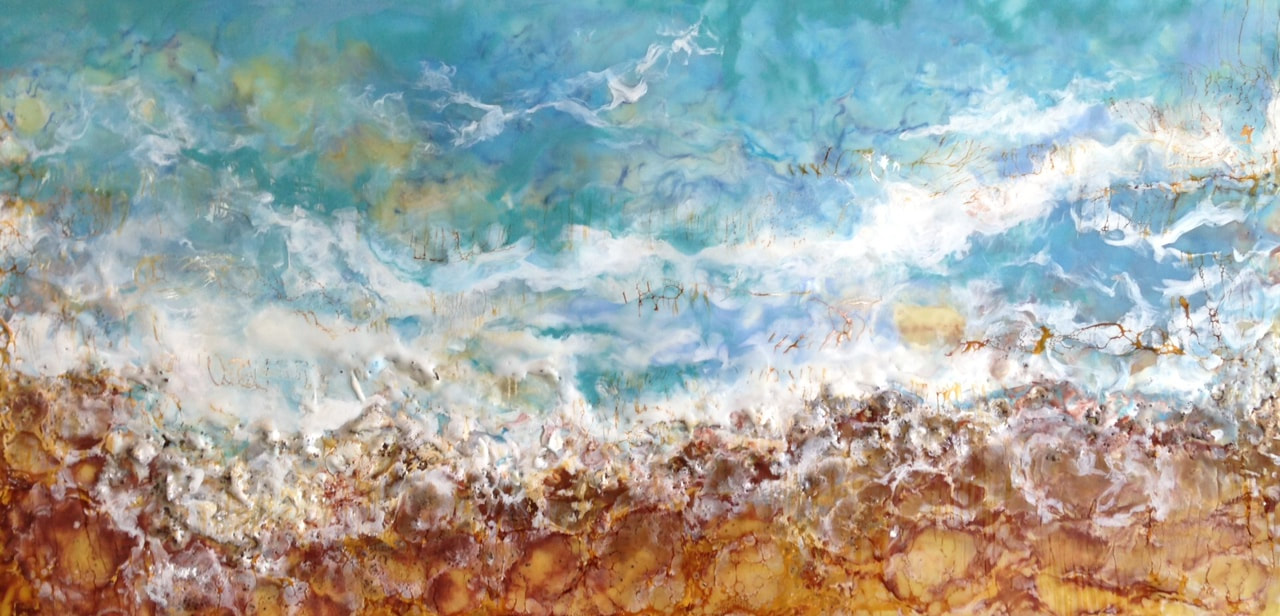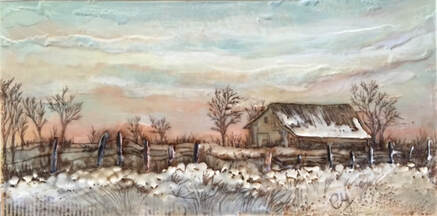About Encaustic
Encaustic technique is an ancient painting style that was practiced by the Greeks and Romans and dates back to the 5th century BC. Best-known examples are the mummy portraits from Egypt having survived over 2000 years without cracking, flaking, or fading. The main component in encaustic is beeswax. Once it has hardened, beeswax is moisture, mildew and fungus resistant, it is also unappetizing to insects.
Contemporary encaustic medium is a combination of beeswax, damar, and pigment. Damar is a hard natural resin that comes from a family of deciduous trees that grow in the East Indies. The resin will harden and cure making the piece less vulnerable to damage. It raises the melting temperature and improves refraction resulting in luminous colours. It's like varnishing the painting from within.
The paint is melted on a warm palette and applied to a warm surface. Each layer is fused to another using a heat gun, torch, or tacking iron. Encaustic paint cools in minutes; additional layers can be added almost immediately. Once the surface has cooled, the paint reaches a permanent finish.
Encaustic is one of the oldest and most archival of all painting mediums with some pieces dating back to thousands of years old.
Care
The care of encaustic is not different than any painting or fine art. Encaustic paintings do perfectly fine in your home, office, and any living environment. It is not recommended to have any painting in or around extreme heat or cold sources for long periods of time. Extreme heat (anything over 200 degrees Fahrenheit or 90 degrees Celsius) may melt the encaustic beeswax medium. Very hot days could soften the wax to some extent, but will cause no real damage. In contrast, wax could be more fragile in the extreme cold and become extremely brittle in freezing temperatures. If you would drop the painting in extreme cold temperatures it will shatter. Keep encaustic paintings out of a hot-parked car with the windows up.
Sometimes, you could notice a natural effect in an encaustic painting called "Bloom". This is part of the curing and hardening process, which occurs when the painting is "young" or recently finished. It is normal and harmless and could be perceived as a light haze that may appear on the surface of the painting. Some paints could take up to a year to cure. There is a very simple solution... all you have to do is buff the painting with a soft cloth. When it is cured it will develop a beautiful long lasting high gloss finish.
Please note that it is not recommended to glass an encaustic piece.
Encaustic technique is an ancient painting style that was practiced by the Greeks and Romans and dates back to the 5th century BC. Best-known examples are the mummy portraits from Egypt having survived over 2000 years without cracking, flaking, or fading. The main component in encaustic is beeswax. Once it has hardened, beeswax is moisture, mildew and fungus resistant, it is also unappetizing to insects.
Contemporary encaustic medium is a combination of beeswax, damar, and pigment. Damar is a hard natural resin that comes from a family of deciduous trees that grow in the East Indies. The resin will harden and cure making the piece less vulnerable to damage. It raises the melting temperature and improves refraction resulting in luminous colours. It's like varnishing the painting from within.
The paint is melted on a warm palette and applied to a warm surface. Each layer is fused to another using a heat gun, torch, or tacking iron. Encaustic paint cools in minutes; additional layers can be added almost immediately. Once the surface has cooled, the paint reaches a permanent finish.
Encaustic is one of the oldest and most archival of all painting mediums with some pieces dating back to thousands of years old.
Care
The care of encaustic is not different than any painting or fine art. Encaustic paintings do perfectly fine in your home, office, and any living environment. It is not recommended to have any painting in or around extreme heat or cold sources for long periods of time. Extreme heat (anything over 200 degrees Fahrenheit or 90 degrees Celsius) may melt the encaustic beeswax medium. Very hot days could soften the wax to some extent, but will cause no real damage. In contrast, wax could be more fragile in the extreme cold and become extremely brittle in freezing temperatures. If you would drop the painting in extreme cold temperatures it will shatter. Keep encaustic paintings out of a hot-parked car with the windows up.
Sometimes, you could notice a natural effect in an encaustic painting called "Bloom". This is part of the curing and hardening process, which occurs when the painting is "young" or recently finished. It is normal and harmless and could be perceived as a light haze that may appear on the surface of the painting. Some paints could take up to a year to cure. There is a very simple solution... all you have to do is buff the painting with a soft cloth. When it is cured it will develop a beautiful long lasting high gloss finish.
Please note that it is not recommended to glass an encaustic piece.

